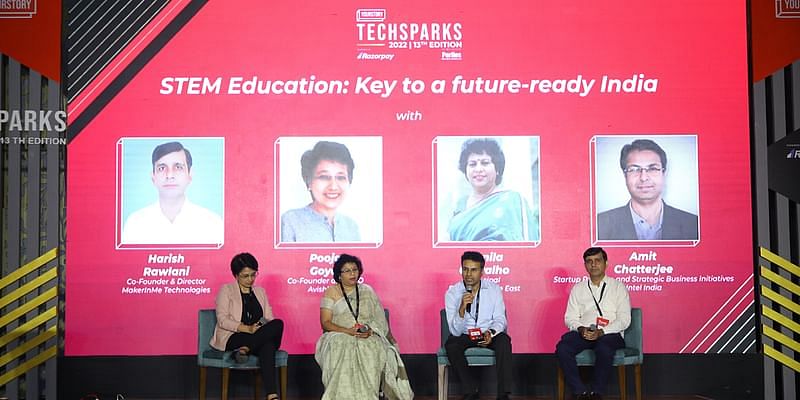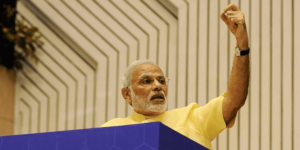Science, Technology, Engineering, and Mathematics: STEM education is helping the Indian tech ecosystem build for the future.
With initiatives such as the Government of India’s National Education Policy in 2020 recognising the importance of these subjects in building a future-ready workforce that will power innovation across industries, a panel discussion on ‘STEM Education: Key to a future-ready India’ at TechSparks 2022 was evidently timely.
Moderated by Amit Chatterjee, Startup Program and Strategic Business Initiatives, Intel India, the conversation featured speakers from edtech and education sector like Pooja Goyal, Co-founder and COO, Avishkaar; Harish Rawlani, Co-founder and Director, MakerInMe Technologies; and Manila Carvalho, Principal, Delhi Public School, Bangalore East.
Amit set the tone of the conversation with a commentary on the booming edtech sector in India. “We have more than 1.4 lakh schools in the country, give or take, that is a big market itself. We also have all the new initiatives that the government of India is pushing for, including the National Education Policy 2020, which says we need to be more activity-oriented, have more experiential and practical-oriented education. And what we want to do today is to have the conversation on how exactly we can enable that,” Amit said.
Investing in STEM education
While Harish spoke about how the current education system is focused on textbooks, exams, and theoretical learning of knowledge rather than the development of skills, he acknowledged that the landscape is changing.
“STEM education is one way to address this problem, to make students learn through hands-on activities and projects. How to create something which will allow students to learn technology — is one of the key challenges when it comes to the technology aspect of STEM education. We have to abstract out technology so that students can learn and find it engaging,” Harish said, adding that all stakeholders at home – parents, teachers, and students themselves – need to be involved in the education process for a holistic and practical understanding of STEM.
Both Manila and Harish also raised the point of how technology is constantly evolving, and the need for edtech products to evolve along with it. Teaching has become a challenge, according to Manila, thanks to the advancement of technology and students having a better grasp and understanding of it.
“In schools across rural and urban areas, most of us [teachers] do not belong to the digital era. We are learning and we are trying, but the pace in which we are doing it is very slow compared to the children who are in the school. So they definitely require support — maybe external support if teachers are not equipped enough,” Manila said, adding that children are a lot more interested in subjects when they involve creating something, and where they can be hands-on.
What needs to change?
A key challenge in the STEM edtech space is dealing with multiple stakeholders, such as parents and schools. With schools having their own curriculum, Pooja said that working with them to incorporate STEM learning takes time. She added that with parents, going through the D2C route, brings about capex limitations.
“The customer acquisition cost is so high, that you end up raising lots of money from venture capital. And I’ve seen up to 50 percent of that money just going to Facebook and Google for performance marketing and customer acquisition. I think in education, you do need a little bit of patience to build a solid business over a period of time. And the current model of funding is not completely attuned to that pace at which it needs to be built,” Pooja shared.
Manila highlighted how teachers need to focus on upskilling themselves and realise the value of non-traditional teaching methods. “Teachers need to be trained for whatever changes, whatever new things we will bring to the schools. If they are convinced, the product will work well on campuses. If they are not, things will not work. So they need to get their confidence to say, ‘Yes, this is working. And our children are learning and this definitely adds more value to my teaching,’” she explained.
In addition to creating policies that reward creative approaches to learning and creating spaces for children to experiment by themselves, it’s important to allow children to learn about failure. Pooja added that it was important for parents and teachers to make children understand the underlying learnings with STEM and creative learning methods.
“Children must learn important skills like tech literacy and problem solving skills — for them to be able to say, how do I structure a solution that will be algorithmic and sequential in nature, that we can scale. So for some of these skills, it is more about teaching computational thinking skills, the vocabulary, how it is applicable to solutions, building real solutions, and that’s a very challenging job,” Pooja concluded.




![Read more about the article [MORNING QUOTE] Don’t worry about failure, you only have to be right once](https://blog.digitalsevaa.com/wp-content/uploads/2023/04/Image664v-1681096352168-300x169.jpg)


![Read more about the article [Funding alert] B2SME embedded fintech platform Rupifi raises $4.1M in pre-series A led by Quona Capital](https://blog.digitalsevaa.com/wp-content/uploads/2021/03/Images805-1616652561383-300x150.jpg)



